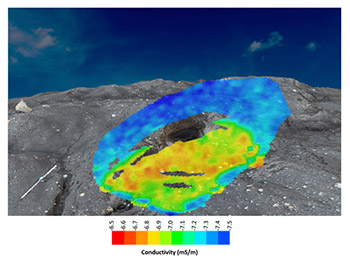Biography
I completed my MSc degree in Geoscience here at Keele University in 2012. During my 4th year I worked in Cantabria, Northern Spain and the Czech Republic, investigating the taphonomy of Lower Middle Cambrian trilobites, combining sedimentary logging with XRF and SEM data.
Since graduating I have worked in the survey industry a geophysicist for LandScope Engineering. I continue to work at LandScope Engineering as principle geophysicist whilst carrying out my research at Keele university on a part-time basis. During my time in industry I have developed a wide range of technical skills from a range of backgrounds including surveying, CAD, 3D modelling, programming, engineering and GIS skills. My PhD research provides opportunity to develop these skills further and apply them to exciting environmental applications.
My PhD thesis focuses on the location and monitoring of buried ice in SE Iceland and Canada and its wider implications in a landsystems setting. Alongside this I am collaborating in other research fields including forensics and engineering. Further information on my research can be found at my website www.huntingforsquiggles.com
Affiliations
Geological Society of London
British society of geomorphology
Quaternary Research Association
Research and scholarship
 Title: Determining the presence and extent of buried ice within glacial environments, a multi-disciplinary approach.
Title: Determining the presence and extent of buried ice within glacial environments, a multi-disciplinary approach.
Supervision: Dr Richard Waller, Dr Alex Nobajas
Glacier recession commonly results in the deposition and burial of ice within the landscape and in some cases can result in the stagnation of the glacier margin and the development of large areas of dead ice. The subsequent ablation of this ice can result in the formation of a range of distinctive features such as discrete kettle holes or more extensive areas of hummocky moraine. Within permafrost environments, the aggradation of permafrost accompanying glacier recession can cause the preservation of buried ice for millennia such that deglaciation of the landscape is incomplete. Recent work within the Canadian Northwest Territories has revealed the development and rapid expansion of megaslumps that result from the exposure and melt-out of buried ice in response to rapid climate change, with the resultant landscape destabilisation having potentially wide-ranging environmental and infrastructural impacts. Very little systematic research has been undertaken to identify the specific landsystem setting in which glacier ice can be buried and potentially persevered.
This project aims to locate, quantify and monitor buried ice within selected localities of Iceland and the Northwest Territories, paying specific attention the landsystem’s context within the glacial environment.
Conferences
Davenward, B. (2018) Determining the extent and land systems context of buried ice within glacial environments. Presented to NSGG Postgraduate Research Symposium 2018. University of Leeds. 16/07/2018.
Davenward, B. (2018) Determining the extent and land systems context of buried ice within glacial environments. Presented to The UK National Earth Observation Conference 2018. Birmingham University. 06/09/2018.
Grants and Funding
NSGG postgraduate fieldwork fund 2018
School of Geography, Geology and the Environment
William Smith Building
Keele University
Staffordshire
ST5 5BG
Tel: +44 (0) 1782 733615
School email: gge@keele.ac.uk


